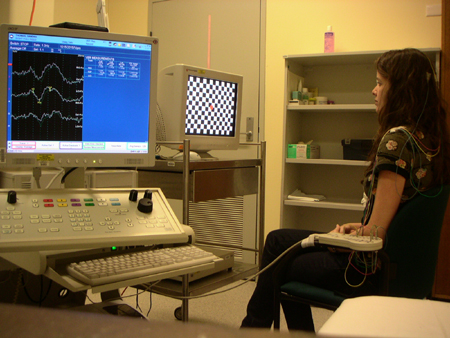Visually Evoked Potential (VEP)
A VEP is an objective testing device that can quantify the functionality of the "visual pathway" (data "streaming" from your EYE to the visual cortex at the back of your brain). When we eye docs find a patient who sees poorly but doesn't have an obvious EYE problem, before we send them for an MRI we can test the "pathway" between the eyes and brain for some problem. This can help us diagnose amblyopia, early glaucoma (before the damage is evident inside the eye), multiple sclerosis, head trauma, brain tumors, etc etc as well as help confirm already suspected diagnoses of those types of conditions. The basic layout is that electrodes are taped to the back of the scalp (near the visual cortex of the brain) and then the patient is SHOWN varying visual stimuli (shapes, patterns, flashes of light, etc) and the information is quantified. I love these types of objective testing where you don't have to ask the patient anything because it gives me data that is unbiased by the patient. Patients can "fake" having bad vision...this test will confirm objectively whether they do or do not have bad vision. You can't fake this type of testing like pretending not to see the acuity chart or the flashing lights of a visual field (both of those are "subjective" tests). On a VEP, if you "see" the images, the electrodes pick up the transmitted signal. Not only do they tell us "yes or no", this patient sees or doesn't see, they also quantify the quality of the signal. It's a great tool and one that we are going to be using a lot more of in the near future...BECAUSE WE JUST BOUGHT ONE!
Patients can "fake" having bad vision...this test will confirm objectively whether they do or do not have bad vision. You can't fake this type of testing like pretending not to see the acuity chart or the flashing lights of a visual field (both of those are "subjective" tests). On a VEP, if you "see" the images, the electrodes pick up the transmitted signal. Not only do they tell us "yes or no", this patient sees or doesn't see, they also quantify the quality of the signal. It's a great tool and one that we are going to be using a lot more of in the near future...BECAUSE WE JUST BOUGHT ONE! 
 Patients can "fake" having bad vision...this test will confirm objectively whether they do or do not have bad vision. You can't fake this type of testing like pretending not to see the acuity chart or the flashing lights of a visual field (both of those are "subjective" tests). On a VEP, if you "see" the images, the electrodes pick up the transmitted signal. Not only do they tell us "yes or no", this patient sees or doesn't see, they also quantify the quality of the signal. It's a great tool and one that we are going to be using a lot more of in the near future...BECAUSE WE JUST BOUGHT ONE!
Patients can "fake" having bad vision...this test will confirm objectively whether they do or do not have bad vision. You can't fake this type of testing like pretending not to see the acuity chart or the flashing lights of a visual field (both of those are "subjective" tests). On a VEP, if you "see" the images, the electrodes pick up the transmitted signal. Not only do they tell us "yes or no", this patient sees or doesn't see, they also quantify the quality of the signal. It's a great tool and one that we are going to be using a lot more of in the near future...BECAUSE WE JUST BOUGHT ONE! 
Comments
Post a Comment